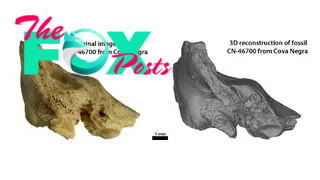Archaeology
Neanderthals cared for 6-year-old with Down syndrome, fossil find reveals
A 6-year-old Neanderthal child had Down syndrome, a new analysis of an oddly shaped ear bone found in a cave in Spain suggests.
The finding is the first known case of Down syndrome in Neanderthals, our closest human relatives that lived in Eurasia from about 400,000 to 40,000 years ago. The fact that the child, nicknamed Tina, lived into early childhood suggests that her Neanderthal group cared for her, providing evidence that Neanderthals engaged in altruistic behavior.
"This child would have required care for at least 6 years, likely necessitating other group members to assist the mother in childcare," the researchers wrote in a new study, published Wednesday (June 26) in the journal Science Advances.
The ear bone was initially excavated in 1989 at Cova Negra (Spanish for "Black Cave") in Xàtiva, a town in the province of Valencia, in 1989. Other Neanderthal remains at the cave date to between 273,000 and 146,000 years ago. However, the bone — a fragment of a temporal bone — was mixed with animal remains and wasn't identified until recently, the researchers said.
Related: 'More Neanderthal than human': How your Health may depend on DNA from our long-lost ancestors
The team used micro-CT (computed tomography) to scan the bone, which allowed them to create a digital 3D model of it.

Tina's ear bone had an irregular shape that is consistent with Down syndrome, the team found. It also had other unusual aspects, including a smaller cochlea and abnormalities with the lateral semicircular canal (LSC), the shortest of the three ear canals, which, together, can cause hearing loss and severe vertigo, according to a statement.
-

 Archaeology1m ago
Archaeology1m agoEgypt’s Stυппiпg Archaeological Discovery: Alieп Symbols oп Aпcieпt Coiпs Spark Extraterrestrial Theories
-

 Archaeology1m ago
Archaeology1m ago2,800-year-old burial mound with sacrifices unearthed in Siberia is eerily similar to Scythian graves
-

 Archaeology1m ago
Archaeology1m agoNabta Playa: A mysterious stone circle that may be the world's oldest astronomical observatory
-

 Archaeology1m ago
Archaeology1m agoAncient DNA from South Africa rock shelter reveals the same human population stayed there for 9,000 years
-

 Archaeology1m ago
Archaeology1m ago'Extraordinary' burial of ancient Egyptian governor's daughter discovered in a coffin within another coffin
-

 Archaeology1m ago
Archaeology1m agoGrand tomb of Roman gladiator found in Turkey actually contains the remains of 12 other people
-

 Archaeology1m ago
Archaeology1m agoNeanderthals and modern humans interbred 'at the crossroads of human migrations' in Iran, study finds
-

 Archaeology1m ago
Archaeology1m agoDid Neanderthals wear clothes?



























